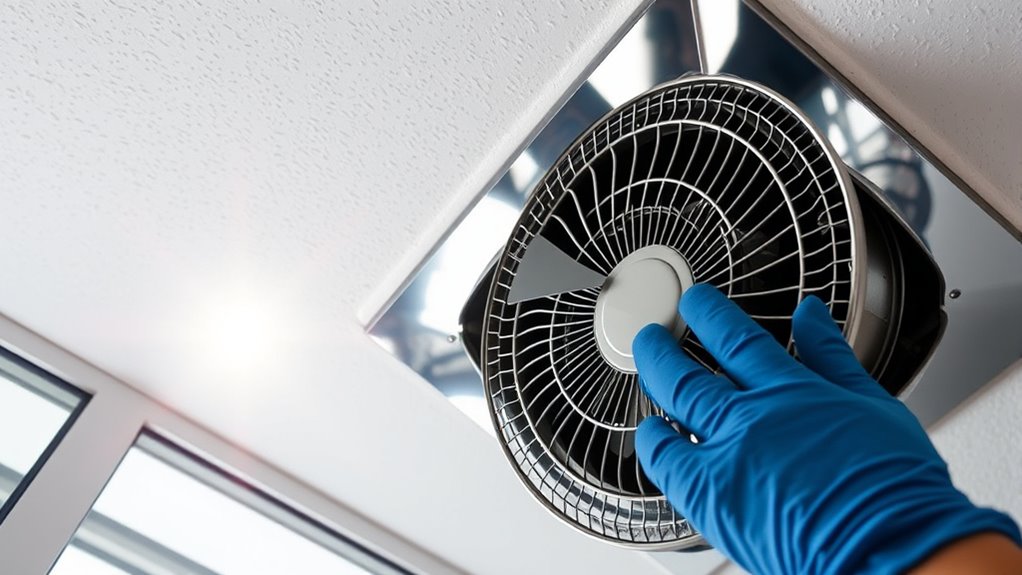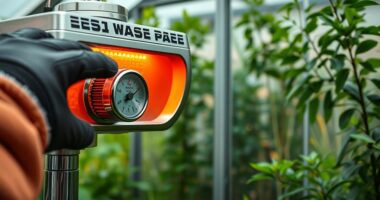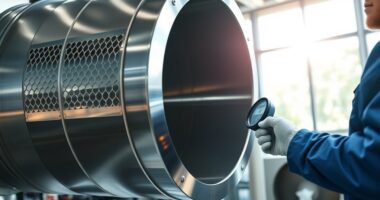To keep fans and vents working effectively all year, regularly inspect and clean them to remove dust, grease, and debris that block airflow. Replace filters as recommended, and guarantee vents are unobstructed and functioning properly. Consider installing timers or humidity sensors to optimize operation based on season and need. Proper duct sealing and insulation also boost efficiency. For tips on maintaining your ventilation system’s performance throughout the year, keep exploring ways to ensure your system runs smoothly.
Key Takeaways
- Regularly inspect and clean exhaust fans, vents, and range hoods to prevent dust, grease, and debris buildup.
- Replace or clean filters periodically to maintain airflow and system efficiency year-round.
- Seal and insulate ductwork to prevent leaks and energy loss, ensuring consistent ventilation performance.
- Install and maintain ventilation controls like timers and humidity sensors for optimal operation across seasons.
- Conduct periodic professional inspections of vents and duct systems to identify and address issues promptly.

Proper ventilation is essential for maintaining healthy indoor air quality and ensuring your heating and cooling systems work efficiently. When your ventilation systems are functioning correctly, they help remove indoor pollutants, excess moisture, and odors, keeping your environment safe and comfortable. Good air quality isn’t just about comfort; it directly impacts your health, especially if you or family members have allergies or respiratory issues. Additionally, well-maintained vents and fans can considerably improve your home’s energy efficiency, reducing utility bills and extending the lifespan of your HVAC units.
To keep your ventilation system in top shape, regular upkeep is critical. Start by inspecting your exhaust fans, bathroom vents, and kitchen range hoods. Dust, grease, and debris can accumulate over time, obstructing airflow and diminishing their effectiveness. Cleaning these vents once every few months ensures they continue to operate smoothly. Don’t forget to replace or clean filters regularly—clogged filters force your system to work harder, wasting energy and reducing indoor air quality. Use high-quality filters suited for your system and change them as recommended by the manufacturer.
Check your air intakes and vents located around your home, especially in areas prone to moisture like basements or laundry rooms. Blocked or dirty vents restrict airflow, which can lead to poor air circulation and increased indoor pollutants. Clear any obstructions like dust buildup or debris, and consider installing vent covers that prevent debris from entering while allowing fresh air to circulate. Properly functioning vents help maintain consistent airflow, which supports ideal indoor air quality and keeps your HVAC system from overworking.
Another essential aspect is ensuring your attic and ductwork are sealed and insulated properly. Leaky ducts waste energy by allowing conditioned air to escape and outdoor air to infiltrate. Schedule a professional duct inspection periodically to identify leaks or blockages. Sealing leaks with appropriate materials and insulating ducts helps your system operate at peak efficiency, conserving energy and maintaining a consistent indoor environment. When your ventilation system runs efficiently, it reduces strain on your HVAC equipment, lowering energy bills and extending its lifespan.
Lastly, consider installing or upgrading ventilation controls like timers or humidity sensors. These devices optimize operation, turning fans on only when needed and preventing excess moisture buildup. This automation can considerably enhance both air quality and energy efficiency, as your system runs only when necessary. Regularly reviewing and maintaining these controls ensures your ventilation system adapts to seasonal changes, keeping your home healthy and energy-conscious all year round. Incorporating proper ventilation strategies supported by the latest technology can further enhance your system’s performance and longevity. Additionally, understanding the best filtration systems, such as HEPA filters, can significantly improve the removal of airborne particles and allergens, promoting a healthier indoor environment.
Furthermore, choosing high-quality filters designed specifically for your system can greatly improve filtration efficiency and indoor air quality, especially in homes with allergy sufferers.
Frequently Asked Questions
How Often Should I Replace My Ventilation Filters?
You should replace your ventilation filters based on their filter lifespan and replacement frequency recommendations, typically every 1 to 3 months. Check your filters monthly, especially during peak usage or if you notice reduced airflow or increased dust. Regular replacements guarantee ideal air quality and system efficiency. Keep in mind that factors like pets, allergies, and indoor air quality can influence how often you need to change filters.
Can Outdoor Weather Affect Vent Performance?
Outdoor weather can totally wreak havoc on your vent performance, like a storm tearing through a calm sea. Weather impact directly affects ventilation efficiency—extreme cold, heat, humidity, or wind can clog, block, or strain your vents. To keep everything working smoothly, you need to regularly inspect and maintain your vents, especially during drastic weather changes. This way, you guarantee ideal airflow and indoor air quality all year long.
What Signs Indicate My Ventilation System Needs Repair?
If your ventilation system needs repair, you’ll notice signs like reduced airflow, which suggests an airflow obstruction, or unusual noises from the fans or vents. You might also smell musty odors or see dust buildup, indicating it’s not functioning properly. Don’t ignore these signs. Regularly check your vents and fans, and if you notice these issues, get them inspected and repaired promptly for ideal airflow and indoor air quality.
Are There Eco-Friendly Options for Ventilation Maintenance?
You’re wondering if eco-friendly options exist for ventilation maintenance. Yes, you can choose solar-powered fans, which use renewable energy to operate efficiently. Additionally, opt for biodegradable vent covers made from sustainable materials, reducing plastic waste. These eco-friendly choices help lower your carbon footprint while maintaining good airflow and ventilation. Incorporating solar-powered fans and biodegradable vent covers guarantees your system stays effective and environmentally responsible all year round.
How Can I Prevent Pests From Entering Vents?
To prevent pests from entering vents, focus on pest prevention by sealing any gaps around your vents with durable, pest-proof materials. Regularly inspect and maintain vent covers, replacing damaged or loose ones promptly. Use fine mesh screens over vents to block insects and rodents while allowing airflow. These steps make sure your vents stay pest-free, helping maintain a clean, healthy environment and reducing potential damage caused by unwanted visitors.
Conclusion
By keeping your fans and vents in top shape year-round, you’re protecting your home from damage and ensuring fresh air flows constantly. Don’t wait until a minor issue turns into a disaster—think of your ventilation system as the heart of your home. Regular upkeep might seem small, but it’s the secret weapon that keeps your living space healthier and safer. Stay vigilant, stay proactive, and your home will thank you with a lifetime of comfort and clean air.









